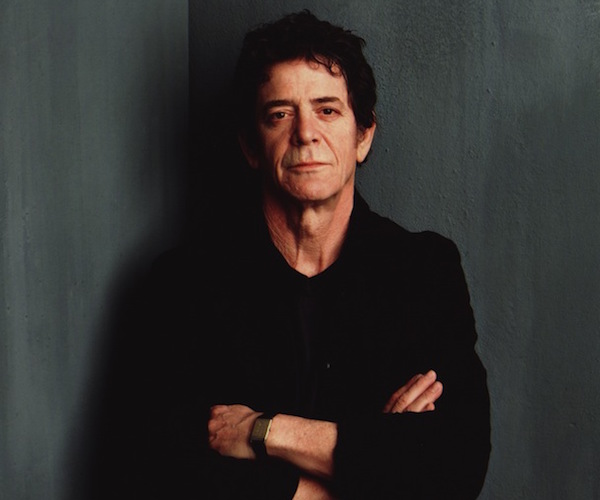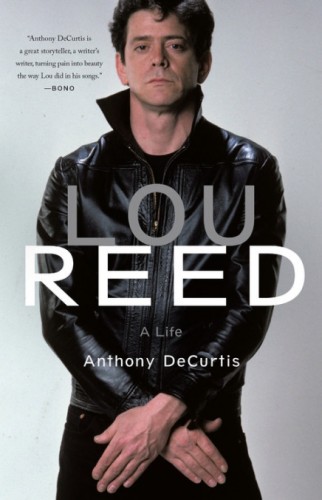Book Review: Lou Reed — A Welter of Contradictions
DeCurtis wants to do justice to his subjects’ extensive catalogue, but as he ticks off the summaries for one record after another the book begins to feel less like exegesis and more like Lou Reed 101.
Lou Reed by Anthony DeCurtis. Little. Brown, 528 pages, $15.99.

Lou Reed — the fertile schizophrenia of his personality fueled the singer/songwriter’s restless creative energy.
By Matt Hanson
In some ways, everything you need to know about Lou Reed is in the name — a sleek, slick, terse pair of punchy syllables that fits the image he projected to the public like a leather glove — that of a scowling, streetwise New Yorker clad in black who wrote songs about illicit drugs, kinky sex, and the underworld that loves them. What many people don’t know is that if it weren’t for his upwardly mobile, status-conscious Jewish family’s desire to blend in to ’50s suburban America, we’d know the songwriter who wrote “Heroin” as Lewis Allan Rudnitsky, an accountant’s son from Long Island.
Both of these archetypes are true — Anthony DeCurtis’s extensive new biography shows how the fertile schizophrenia of Lou’s personality fueled his restless creative energy. Reed was able to intermingle his contradictions — equal parts edgy, downtown provocateur and bookish, middle class intellectual — into the complex, pioneering music that influenced the shape of rock to come.
The welter of contradictions were present at the beginning. Reed was ambivalent about his middle-class upbringing from the cradle. While his friends were sneaking beers and peeking at Playboys, Reed was smoking pot and reading the Marquis De Sade. He took a progressively matter-of-fact approach to the risqué subject matter: “This is just what some people enjoy.” A track star who loved avant-garde jazz, Reed also maintained a lifelong love for doo-wop, infusing its swooning romanticism into some of his most vulnerable songs. The adolescent Reed was a teenage loner who liked reminding people that he never actually enjoyed any of the parties he was continually invited to.
Reed’s androgynous sexuality would now neatly be categorized as “non-binary,” but his effeminate mannerisms scandalized his anxious parents. He was administered electroshock treatments (a not uncommon practice at the time), a harrowing experience he revisited many years later in the bitter “Kill Your Sons.” DeCurtis referees the debate about how much blame Reed’s parents deserve. His sister insists they were skittish, but genuinely thought the electroshock treatment was for the best — given the crude understanding of mental health at the time. Reed remained unforgiving his whole life, and DeCurtis points out that Oedipal themes recur in many of his songs.
The biographer also suggests, albeit too formulaically, that this Freudian archetype is what generated Reed’s tumultuous romantic life. Via a frustratingly pat judgment, DeCurtis argues that Lou’s interest in men seemed more erotic in nature, his interest in women more domestic. He posits that Reed’s ultimate motivation was to find a nurturing, nonjudgmental mommy figure — an armchair Freudian verdict if ever there was one. Yes, Reed married three different women, but the characterization is irritatingly reductive. Reed engineered plenty of transformations in his life: just because he tended to settle down longest with women doesn’t necessarily mean his queerness was just an affectation or a passing fancy.
One of the largely forgotten people in Reed’s tumultuous love life was the elusive figure known as Rachel, the trans woman with whom he was very vocally in love for several years, proclaiming that “Rachel knows how to love me better than anyone” and to whom his heartfelt “Coney Island Baby” is dedicated. Little is known about her other than her relationship with Reed, and DeCurtis uses most of the section of the book devoted to her deservedly criticizing critic Lester Bangs’ belittling of her during one of his infamous interviews.
It’s amusing to learn that the college girlfriend who was the inspiration for “Pale Blue Eyes” (arguably his greatest ballad) didn’t actually have blue eyes. I loved finding out that “Perfect Day” was written about a blissful New York afternoon spent with his first wife Betty Kronstad, who spent the day hiding her bleeding ankles (casualties from a poorly selected choice of shoes) from Lou so as not to spoil the moment. Evidently the best way to Reed’s heart was by connecting with his inner techno geek — he met his soul mate Laurie Anderson at an Audio Engineering Society convention. He immediately bonded with the independent and accomplished fellow musician while shop talking electronics.

Always finding himself at the right place at the right time, Reed had a lifelong knack for finding powerful mentors. At Syracuse it was poet and short story writer Delmore Schwartz, former golden boy of the Partisan Review. He had gone haywire from booze, but was still able to command rapt attention. Schwartz once demanded that Reed promise to write honestly and never sell out or risk being haunted by his ghost. Reed took his mentor at his word; he honored his memory for the rest of his career, never breaking his promise. Schwartz’s literary obsessions reinforced Reed’s sense of himself as a serious writer, which he always considered his true legacy.
Reed said that Schwartz was the smartest man he had ever met, until he met Andy Warhol. As the patron for the Velvet Underground (named after the title of a book, a cheap shocker about S & M practices in suburbia), Warhol provided a performance space for the group and used all the multimedia at his disposal (whip dancers, film projection) to set-up a Factory that throbbed with all the glamorous freaks Reed could ever want. Even as he learned from these eccentric creators, Reed’s stubborn independence and solitary nature meant that he couldn’t stand to share the spotlight with a collaborator or be under the thumb of any authority figure for long. It took a while, but Reed and his VU bandmate John Cale eventually reconciled their differences and reunited for the underrated record Songs for Drella which explores his relationship to Warhol with time-earned objectivity.
After the VU disbanded, Reed’s solo career had its peaks and valleys. Transformer is probably the most well-known of his solo records, but Berlin and Rock and Roll Animal, though initially flops, have grown in stature over time. DeCurtis offers close readings of his best work. When his scholarly attention (DeCurtis has a PhD in Literature) is applied to Reed’s best material, such as his magnum opus “Street Hassle,” the analysis enhances the songs. When it isn’t, as when he compares the comical ditty “Goodnight Ladies” to T.S. Eliot’s “The Waste Land,” the scholarly references come off as forced. I happen to think more of Reed’s later work, such as the somber album Magic and Loss, than DeCurtis does, but generally his taste is on point.
For long time fans, the book’s biggest issue is its briskness. DeCurtis wants to do justice to his subjects’ extensive catalogue, and that is well-intentioned, but as he ticks off the summaries for one record after another the volume begins to feel less like illuminating exegesis and more like Lou Reed 101. Perhaps his goal is to turn the next generation on to Reed’s pioneering music, which is necessary given our consumerist culture’s reluctance to honor the past. Reed himself once mordantly remarked that they would be playing “Walk on the Wild Side” (his only hit song) at his funeral, and he wasn’t wrong. It was played, but his entire catalogue was also broadcast throughout the streets of New York City to mourn his passing. Hopefully, DeCurtis’ encyclopedic approach will inspire younger readers to listen more closely.
Matt Hanson is a critic for The Arts Fuse living outside Boston. His writing has appeared in The Millions, 3QuarksDaily, and Flak Magazine (RIP), where he was a staff writer. He blogs about movies and culture for LoveMoneyClothes. His poetry chapbook was published by Rhinologic Press.

Very interesting, informed review, though Laurie Anderson barely mentioned and not one word about Nico. I’d love to hear your thoughts, Matt.
Thanks for reading, Gerry.
There’s more in the book about Laurie Anderson than I could fit in the review, and it certainly seems that she was the love of his life. Probably a big part of that had to do with the fact that she was an accomplished, respected, artist in her own right and thus had Lou’s respect and kept what seemed to be his occasional tendency to be rough with his loved ones at bay. I don’t know her work all that well, personally.
As for Nico, DeCurtis doesn’t talk about her too much. She gets her due, but as far as the VU is concerned she was more of a cameo than anything else. Her relationship with Lou was pretty brief, as well. I know her work fairly well, and her first two records are really powerful.
I wonder how much of that is true and how much of that is just part of the (possibly self-created) Lou Reed mythos. When Reed quit the Velvet Underground, he moved back in with his parents and even worked at his father’s firm until he could restart his musical career as a solo artist.
Hey Ian
Well, what you’re saying is definitely also true. Based on what I’ve seen, the electroshock episode definitely happened. It might have been multiple visits, I’m not sure, but it did happen. DeCurtis points out the controversy behind his parents’ intention, some say it was out of genuine worry and others (like Lou) feel it was more of a bullying gesture. I think Lou had, to put it mildly, a deep ambivalence about his family the rest of his life.
No question that Lou had a a level of ambivalence about that episode; but the “behind the music” behavior at least suggests that there was a bifurcation between the Lewis Allan Rudnitsky who continued to have a relationship with his parents, and the Lou Reed of his songwriting and interviews who cultivated an image of a romantic and transgressive artist who had been tortured in his youth by a society that didn’t understand.
And of course — both of these personae are likely equally authentic.
O certainly- I think part of what made his music great in the first place was how he was always between two worlds- the “hip” and the “straight” if you will- and he managed to combine the two in one career. He’s the guy who could write “Coney Island Baby” and “Kill Your Sons”; “Satellite of Love” and “Street Hassle” (which we both agree is his best solo song). So there’s no reason that I can see why his personal life didn’t influence that.